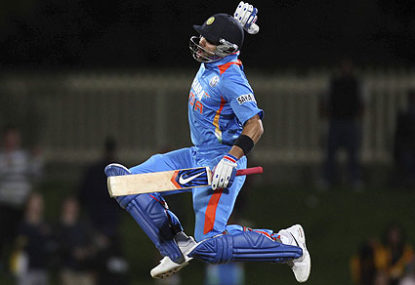Will the SCG semi-final between Australia and India on the SCG equal the Kiwi-Proteas cliffhanger at Auckland for suspense and raw drama?
Who will meet the on-song New Zealand in the final on the MCG on Sunday? We’ll know tonight.
For the first time ever, Australia and India will meet in a semi-final at the World Cup.
They did meet in the final at Johannesburg in 2003, when Australia won.
Today will see the clash of the champions, Australia and India, on the SCG. Since 1999 they have won all four World Cups: Australia in 1999, 2003 and 2007 and India in 2011.
Australia defeated India twice in 2003, by nine wickets in Centurion and by 125 runs in the Final in Johannesburg.
This is the seventh time Australia has entered the semi-finals, having done so in the inaugural year (1975) and then in 1987, 1996, 1999, 2003 and 2007.
Australia won the semi-finals in 1975, 1987, 1996, 2003 and 2007 and tied with South Africa in 1999 but won because they had finished higher on the Super Six table.
They went on to become champions in 1987, 1999, 2003 and 2007.
India’s record is similar. They have entered the semis six times: in 1983, 1987, 1996, 2003, 2011 and 2015. They won in 1983, 2003 and 2011 and lifted the Cup in 1983 and 2011.
Of the 10 CWC matches between them, Australia is ahead winning seven and losing three. But as Australia won two of these matches by one run (at Chennai in 1987 and at Brisbane in 1992), it could well have been five-all.
Against all countries, Australia has won 60 out of their 82 CWC matches losing 20, with one tied and one with no result.
Against all countries, India has won 46 out of their 74 CWC matches, losing 26, with one tied and one with no result.
Thus Australia has a superior over-all result.
However, India has performed better in the 2015 CWC, winning all their seven matches. Australia has won five, lost one (to New Zealand by one wicket) with one match against Bangladesh abandoned.
Now let us evaluate the contestants for the so-called heavyweight championship.
In the blue corner is India led by the cool cat MS Dhoni. In the yellow corner is Australia captained by a grown up ‘Pup’: Michael Clarke.
Below are their stats in the 2015 CWC, as we assess the combatants round by round as if in a boxing match.
Openers for Australia: Between Dave Warner and Aaron Finch, they scored 487 runs at an average of 44.27 and a strike rate (SR) of 116.78. They hit two centuries and 13 sixes.
Openers for India: Between Rohit Sharma and Shikhar Dhawan, they scored 663 runs at 51.00 and a SR of 92.08. They hit three centuries and 15 sixes.
The opening round goes to India.
The middle order: Among those middle-order batsmen scoring 175 or more runs, three are Australians and two are Indians.
The three Australians – Glenn Maxwell, Steve Smith and Shane Watson – scored 720 runs between them at average of 55.38 and at a SR of 120.00, hitting one century and 18 sixes.
The two Indians – Virat Kohli and Suresh Raina – scored 581 runs at an average of 64.55 and a SR of 95.56, hitting one century and nine sixes.
The second “round” is so close that the match referee is confused and calls it a draw.
Now to the bowlers: Of the bowlers taking ten or more wickets, two are Australians (both fast bowlers) and four are Indians (three fast bowlers and one spinner).
The two Australians – Mitchell Starc and Mitchell Johnson – have taken 28 wickets at a combined average of 15.07, economy rate of 4.61, strike rate of 19.06 and taken four or more wickets in a match three times.
The four Indians – quickies Mohammed Shami, Umesh Yadav and Mohit Sharma and off-spinner Ravichandran Ashwin – have captured 54 wickets at a combined average of 18.55, economy rate of 4.48, strike rate of 25.14 and taken four wickets in a match three times.
The third round is again very close but the referee has given it to Australia because of Starc’s magnificent figures. He has taken the second most number of wickets, 18, behind only to New Zealander Trent Boult, 21 wickets.
But Starc has the best bowling average, 9.77 (Boult averaged 15.76), the best economy rate of 9.77 and the best strike rate of 15.6. Also Starc is the only one to take six wickets in an innings, 6 for 28.
Now the score is one-all.
Finally to the wicket-keeper: India’s MS Dhoni has better stats. He has 15 catches and 172 runs at 57.33 to Australia’s Brad Haddin, 11 catches and 119 runs at 39.66. Both have hit four sixes.
Again close but India gets round four to lead two-one.
What about the home advantage to Australia? Don’t be ridiculous. Having played on Australian pitches since November 2014, Dhoni’s men know every blade of grass on Aussie turf.





























































































